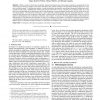Free Online Productivity Tools
i2Speak
i2Symbol
i2OCR
iTex2Img
iWeb2Print
iWeb2Shot
i2Type
iPdf2Split
iPdf2Merge
i2Bopomofo
i2Arabic
i2Style
i2Image
i2PDF
iLatex2Rtf
Sci2ools
TVCG
2010
2010
"behaviorism": a framework for dynamic data visualization
— While a number of information visualization software frameworks exist, creating new visualizations, especially those that involve novel visualization metaphors, interaction techniques, data analysis strategies, and specialized rendering algorithms, is still often a difficult process. To facilitate the creation of novel visualizations we present a new software framework, behaviorism, which provides a wide range of flexibility when working with dynamic information on visual, temporal, and ontological levels, but at the e providing appropriate abstractions which allow developers to create prototypes quickly which can then easily be turned into robust systems. The core of the framework is a set of three interconnected graphs, each with associated operators: a scene graph for high-performance 3D rendering, a data graph for different layers of semantically-linked heterogeneous data, and a timing graph for sophisticated control of scheduling, interaction, and animation. In particular, t...
| Added | 31 Jan 2011 |
| Updated | 31 Jan 2011 |
| Type | Journal |
| Year | 2010 |
| Where | TVCG |
| Authors | Angus Forbes, Tobias Höllerer, George Legrady |
Comments (0)

